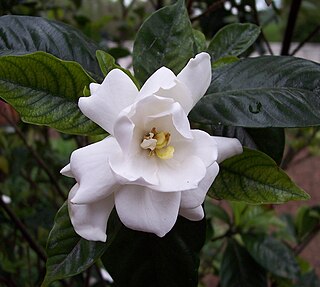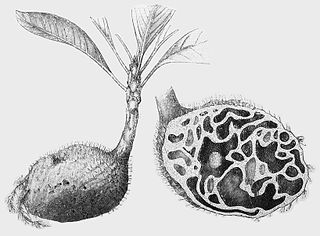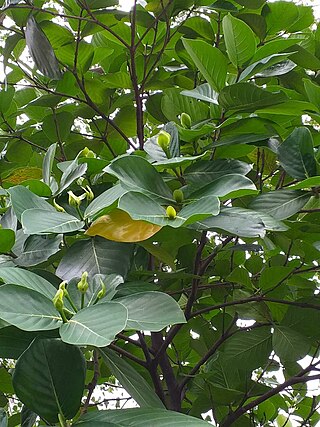
Uncaria is a genus of flowering plants in the family Rubiaceae. It has about 40 species. Their distribution is pantropical, with most species native to tropical Asia, three from Africa and the Mediterranean and two from the neotropics. They are known colloquially as gambier, cat's claw or uña de gato. The latter two names are shared with several other plants. The type species for the genus is Uncaria guianensis.

Melicope is a genus of about 240 species of shrubs and trees in the family Rutaceae, occurring from the Hawaiian Islands across the Pacific Ocean to tropical Asia, Australia and New Zealand. Plants in the genus Melicope have simple or trifoliate leaves arranged in opposite pairs, flowers arranged in panicles, with four sepals, four petals and four or eight stamens and fruit composed of up to four follicles.

Gardenia is a genus of flowering plants in the coffee family, Rubiaceae, native to the tropical and subtropical regions of Africa, Asia, Madagascar, Pacific Islands, and Australia.

Syzygium is a genus of flowering plants that belongs to the myrtle family, Myrtaceae. The genus comprises about 1200 species, and has a native range that extends from Africa and Madagascar through southern Asia east through the Pacific. Its highest levels of diversity occur from Malaysia to northeastern Australia, where many species are very poorly known and many more have not been described taxonomically. One indication of this diversity is in leaf size, ranging from as little as a half inch to as great as 4 ft 11 inches by sixteen inches in Syzygium acre of New Caledonia.

Macaranga is a large genus of Old World tropical trees of the family Euphorbiaceae and the only genus in the subtribe Macaranginae. Native to Africa, Australasia, Asia and various islands of the Indian and Pacific Oceans, the genus comprises over 300 different species. It was first described as a genus in 1806, based on specimens collected on the Island of Mauritius.

The genus Cayratia consists of species of vine plants, typical of the tribe Cayratieae. Some of them are useful, and they are found in tropical and subtropical areas of Asia, Africa, Australia, and islands of the Pacific Ocean.

Canthium is a genus of flowering plants in the family Rubiaceae. They are shrubs and small trees. The leaves are deciduous and the stems are usually thorny.

Psydrax is a genus of flowering plants in the family Rubiaceae. It consists of trees, shrubs, and a few lianas in the paleotropics.

Hydnophytum is a genus of epiphytic myrmecophytes native to Southeast Asia, the Pacific region and also extending into Queensland in northern Australia. The name is derived from the Ancient Greek hydnon "tuber", and phyton "plant", after their appearance with their swollen succulent stems. The species grow in tree branches and on trunks. Like the related genus Myrmecodia, they are known as antplants or ant-house plants. The type species is Hydnophytum formicarum from the Philippines. The genus contains 55 species, of which 44 are found in and around the island of New Guinea. Many are poorly known, with 11 known only from the holotype.
Hedyotis (starviolet) is a genus of flowering plants in the family Rubiaceae. Many species of this genus such as Hedyotis biflora, H. corymbosa and H. diffusa are well known medicinal plants. Hedyotis is native to tropical and subtropical Asia and to islands of the northwest Pacific. It comprises about 115 species. The type species for the genus is Hedyotis fruticosa.

Kadua is a genus of flowering plants in the family Rubiaceae. It comprises 29 species, all restricted to Polynesia. Twenty-two of these are endemic to the Hawaiian Islands. Some of the species are common at high elevation. Others are single-island endemics or very rare, and a few are probably extinct. Kadua affinis is widely distributed in Hawaii and is polymorphic. The type species for the genus is Kadua acuminata.

Neonauclea is a genus of flowering plants in the family Rubiaceae. It comprises about 71 species. Neonauclea is a genus of shrubs and trees They are indigenous to China, India, Southeast Asia, Wallacea, New Guinea and Australia.
Amaracarpus is a genus of shrubs, treelets or trees in the family Rubiaceae. It was described by Carl Ludwig Blume in 1826. Most of the species are endemic to New Guinea but a few have wider ranges in Southeast Asia from Myanmar (Burma) and the Andaman Islands across Thailand, Malaysia, Indonesia, the Philippines, Melanesia, Christmas Island, Queensland and Vanuatu. One species also occurs in the Seychelles. Several species were published years ago but are today not represented by any type specimens or other known existing material.
Leptomischus is a genus of plants in the family Rubiaceae, native to southern China and southeast Asia. A 2019 molecular phylogenetic study placed it in the tribe Argostemmateae.

Coptosapelta is a genus of flowering plants in the family Rubiaceae. It is found in tropical and subtropical Asia. The genus has not been placed within a subfamily and is sister to the rest of Rubiaceae.
Dolianthus is a genus of flowering plants in the family Rubiaceae. The genus is endemic to New Guinea.
Dolicholobium is a genus of flowering plants in the family Rubiaceae. The genus is found from central Malesia to the southwestern Pacific.
Pandanus brosimos, the wild karuka, is a species of tree in the family Pandanaceae, endemic to New Guinea. Along with Pandanus julianettii, it is widely harvested in New Guinea as a traditional food source. Many local ethnic groups make use of pandanus languages when harvesting the nuts.
Uncaria perrottetii, known locally in the Philippines as “sungay kalabaw”, is a species of liana in the family Rubiaceae.
Achilleanthus is a genus of flowering plants in family Rubiaceae. It includes seven species native to the Lesser Sunda Islands, New Guinea, and the southwest Pacific.












